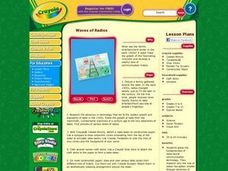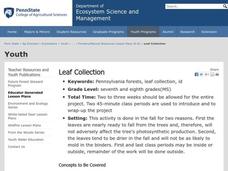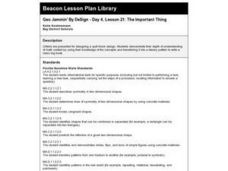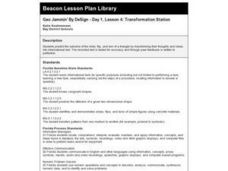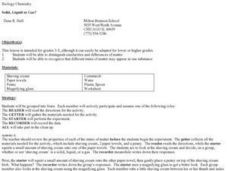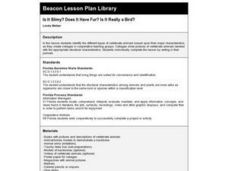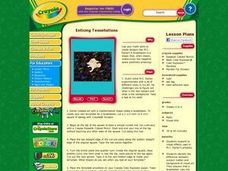Curated OER
Mighty Minerals
Students identify the characteristics of minerals. They complete proper identification tests and record the data in an organized fashion. They list important uses for minerals as well.
Curated OER
Levers and Wedges in the Human Body
Students identify the various parts of the body that serve as wedges and levers, identifying the fulcrum for each body lever. They bite into carrots and apples to analyze how their jaws and teeth work, then complete three worksheets that...
Curated OER
Treasure Tales
Create an artifact kit to engage your young learners. Then, assign small groups a section of chapter three. They will identify the main idea and three supporting details for their section. Then, they select one artifact from the kit that...
Curated OER
Waves of Radios
Students grasp the fundamentals of radio/sound communication technology. They research why the size of radios has gotten smaller through advances of technology...from large radio tubes through transistors through microchips. Students...
Curated OER
Leaf Collection
Learners examine the tree species in Pennsylvania. In this Pennsylvania tree lesson students use field guides to assist them in identifying tree species.
Curated OER
Essential to Autumn: Line, Shape, Color, Texture, Pattern, Rhythm, Emphasis, Movement, Balance, and Unity
Students explore the environment by learning about nature. For this art lesson, students go on a walk and find objects to help in creating a picture, or collage representing whatever season is being discussed. Students write similes...
Curated OER
Geo Jammin By Design: The Important Thing
Young scholars brainstorm what they know about geometric terms and patterns. They identify symmetry, shapes and congruency. They create a book of symmetry.
Curated OER
What Is in a Rock?
Students identify, sort, and classify mineral samples that make up a common rock.
Curated OER
Geo Jammin' By DeSign - Day 1, Lesson 4: Transformation Station
Second graders manipulate triangles to discover the concepts of slides, flips and turns of a geometric shape.
Curated OER
Count Them Up
Pupils calculate area using the geoboard application on their calculators. They use a TI-73 calculator to find the areas of the shapes provided in the accompanying worksheet. Screen shots and instructions for creating shapes in the...
Curated OER
Tree Talk
Learners discuss trees, leaves, and the growth process For this 1st - 3rd grade lesson plan, students identify various types of leaves, recognizing the differences in size and shape. Learners create tracings of various leaves to...
Curated OER
Sobriety Testing Stations
High schoolers identify each of the different sobriety tests and how they are used to detect the amount of alcohol consumed by a person and the physical affects of drinking alcohol.
Curated OER
Solid, Liquid, Or Gas?
Students identify physical characteristics and group objects for a picnic using the states of matter for each object and using literature to introduce the states of matter.
Curated OER
Is It Slimy? Does It Have Fur? Is It Really a Bird?
Sixth graders identify the different types of vertebrate animals based upon their major characteristics, as they create collages in groups. Collages show pictures of vertebrate animals labeled with the appropriate structural...
Alabama Learning Exchange
Who Sank the Boat?
Fifth graders experiment with student-made aluminum boats to test for buoyancy. They design a boat and determine how many marbles it takes to sink it while recording their data in a spreadsheet. They design a graph using the data and...
Curated OER
Word Play
Students examine the history of Chinese American artist Xu Bing. In this multicultural instructional activity, students collaborate in small groups to identify letters in the artist's work, and brainstorm how they would create their own...
Curated OER
Countdown Challenge: Triangle Inequality Theorem
In this triangle inequality instructional activity, students test the Triangle Inequality Theorem. They measure the sides of given triangles, identify the type of triangle, and name angles in the triangle. The one-page instructional...
Curated OER
Enticing Tessellations
Students respond to visual effects used in M.C. Escher's artworks. They identify the difference between subject matter and background of visual art. They compare and contrast the basic shapes to create a tessellation with the more...
Alabama Learning Exchange
Polygon Perimeters
What are polygons? Learners find the perimeter of various geometric figures that the teacher has drawn in chalk on the sidewalk. A worksheet to record their measurements is provided. Get your third graders outside and exploring the world...
Curated OER
City of Rainbows
Students identify the characteristics of a city including infrastructure, architecture, location, transportation, air quality, and suburbs. They recognize how cultures and the environment shape cities. They then identify the needs of a...
Curated OER
Heart-y Creatures
Students research the historical background of Valentine's Day. They identify symbols and examine how this occasion is celebrated today. They create imaginative creatures made out of chenille sticks and paper hearts or other geometric...
Curated OER
Tessellations: Use Right Angles To Explain The Tessellation of Objects
Students examine a selection of shapes and identify which shapes tessellate and why. They design and make a pattern which involves translation, reflection, or rotation. Students describe the features of 2-dimensional and 3-dimensional...
Curated OER
Polygons All Around Us!
Students explore the concept of polygon properties. In this polygon properties lesson plan, students draw polygons with different numbers of sides such as pentagons, octagons, hexagons, etc. Students identify different geometric shapes...
Curated OER
Normal Probability Plot
Young scholars analyze the graph of a distribution. For this statistics lesson, students define skewed or mound shape distribution as they investigate the data behind the graph. They define and plot outlier as well as normal probability.



